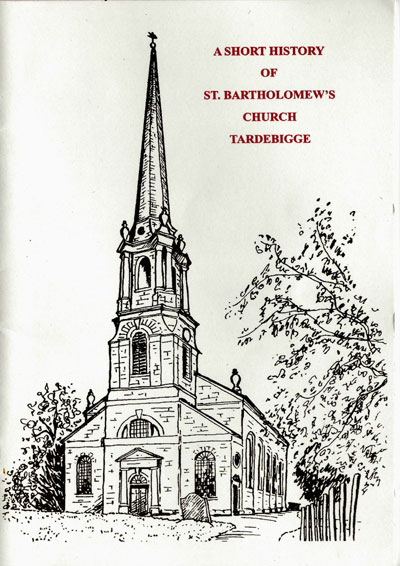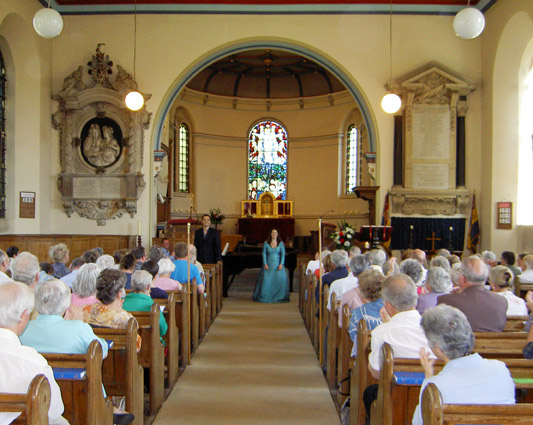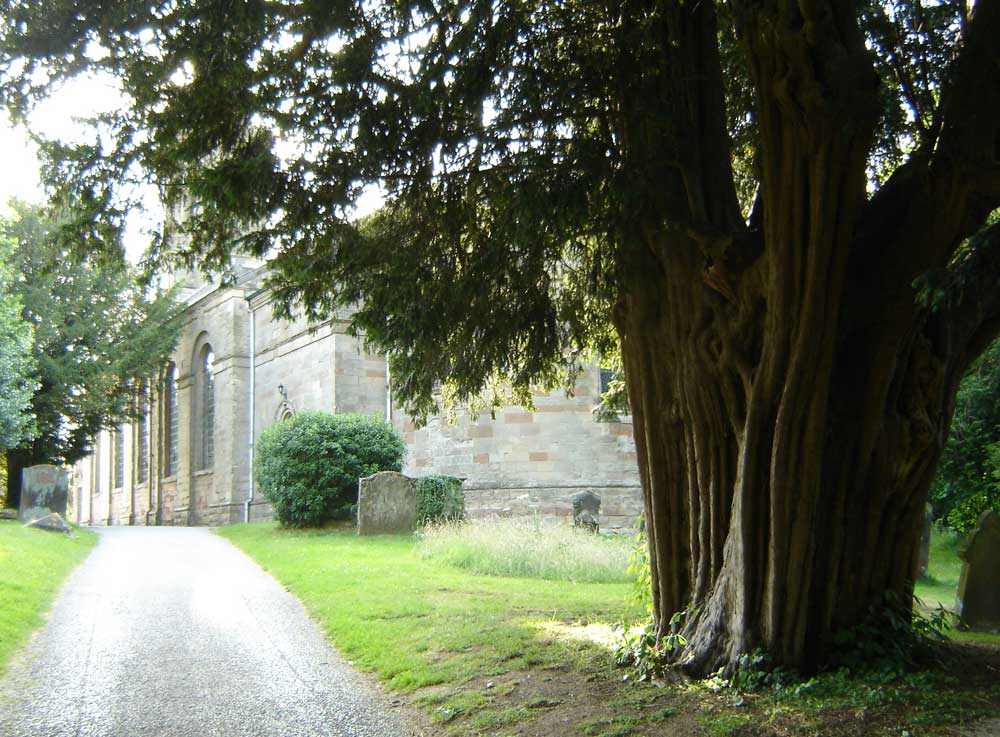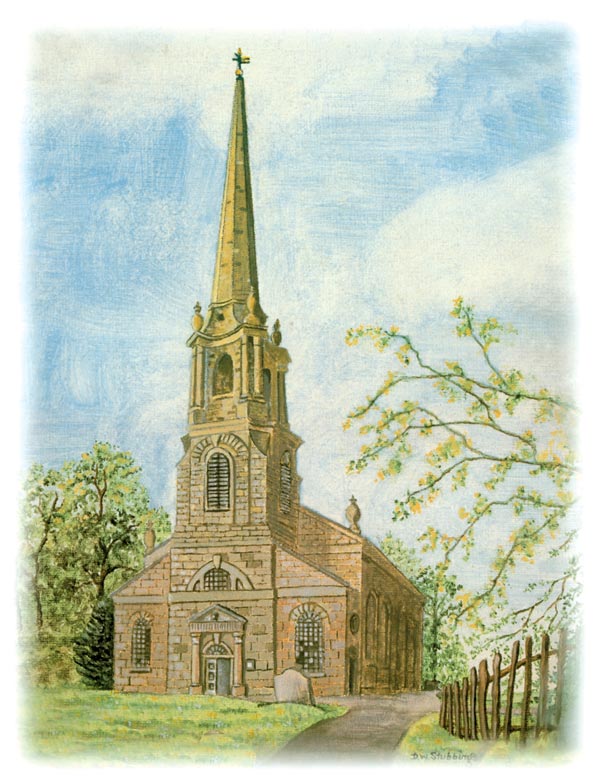A brief history of St Bartholomew’s church
Much of the information here is taken from the booklet ‘A Short History of St Bartholomew’s Church Tardebigge’ by David Harris (see Further reading below).
This and another booklet – about the history of the Birmingham and Worcester canal – are available to buy at the back of the church.
An important part of St Bartholomew’s (fairly recent) history has been its close relationship with Hewell Grange, through the patronage of the Earls of Plymouth and the Windsor family who lived there. Many members of those families are memorialised inside the church and outside.
But the church may be able to trace its history to a time long before Hewell Grange.

Early history
The ‘commanding position’ where St Bartholomew’s church now stands may have been a sacred site for a thousand years or more.
The evidence for this is no more than circumstantial, but still intriguing.
The ancient yew trees (often associated with religious sites) that stand either side of the entrance to the church grounds, are believed to be over a thousand years old.
And it’s been suggested that the unusual name ‘Tardebigge’ has origins in the Saxon for ‘big tower’ or ‘tower on a hill’.
What may be more reliable is an eighteenth century account of the history of St Bartholomew’s. It describes the church, as it was then, as having been built around an original structure possibly dating from just after the Norman Conquest in 1066.
But it appears to be more certain that there was a church, ‘dedicated to St Bartholomew’, on the site in 1138. This was when the parish of Tardebigge formed part of the endowment of Bordesley Abbey.
There is almost nothing left now of the Cistercian abbey of Bordesley, which fell into decline following the dissolution of the monasteries in 1538.
You can read more about the history of Bordesley Abbey on the Forge Mill museum / Bordesley Abbey website.
Click here for the Bordesley Abbey page on that website. (Link opens in a new window.)
Later history
The present St Bartholomew’s is not the (seemingly much grander) church described in the eighteenth century account just mentioned.
Despite its ‘imposing monuments’ and ‘stately pillars’, that building was effectively destroyed when the tower collapsed in September 1775.
The rebuilding of the church was completed in 1777, in a position slightly to the north of the old one.
This, apparently, removed one of the curious features of St Bartholomew’s.
The county boundary, as it was then drawn, ran right through the church. This meant that the main part of the building was in Worcestershire, while the chancel was in Warwickshire!
Tardebigge itself has a chequered history when it comes to county boundaries, having been part of Shropshire at one time as well as Worcestershire and Warwickshire.
The general confusion this caused is well described by Margaret Dickins in her book ‘A Thousand Years in Tardebigge’ – see Further reading.
The church now
The St Bartholomew’s you see now is the result of further restoration to the chancel (completed 1879) and in 1902 to the 135 foot high ‘graceful, slender spire’.
The 1877-79 restoration also simplified a bizarre arrangement of the pews. Before then, the layout meant that, among other inconveniences, ‘the occupiers of the northern pews had to climb over the backs of the others to get to their seats’, and other pews had their backs to the pulpit!
Fortunately, the present arrangement of the pews is more conventional and in keeping with the elegant simplicity of the rest of the interior. Only part of one of the old box pews remains, on the north wall beneath one of the ‘few but fine’ monuments David Harris describes in more detail in his booklet.

The picture here is from a recent series of concerts at St Bartholomew’s by Celebrating English Song.
A review of one of their concerts included this description of the church:
“This airy, well-lit Georgian building set amid glorious North Worcestershire countryside proved the ideal venue for Sunday afternoon’s recital”.
There’s more in David Harris’ booklet about the church’s history and monuments, its “cheerful bells and other matters” including its patrons, arts and crafts and incumbents – see Further reading.
Further reading
Each of the links below opens in a new window.
- A Short History of St Bartholomew’s Church Tardebigge by David R Harris LLM, published in 1977 (latest reprint 2009). For sale inside the church and from ASAP Printing, 35 Birchfield Road, Headless Cross, Redditch B97 4LB. Phone 01527 546169.
- A Thousand Years in Tardebigge by Margaret Dickins, published in 1931. Long out of print, but you may be able to borrow a copy from some Worcestershire libraries.
- A Hundred Years in Tardebigge by Rev Alan White, published by Brewin Books in 2011. Still available to buy on-line and from local bookshops.
Useful links
Each of the links below opens in a new window.
- British History Online: a detailed history of the parish of Tardebigge, the church and surrounding areas. Click here to link to the web page.
- A Vision of Britain Through Time – Tardebigge: a website set up by the University of Portsmouth, with historical references, census statistics and maps relating to Tardebigge (listed as being in Warwickshire, rather than Worcestershire): click here to link to the web page.
- Worcester Branch of the Birmingham and Midland Society for Genealogy and Heraldry: useful information for tracing family history in Tardebigge. Click here to link to the web page.
- Worcester Branch of the Birmingham and Midland Society for Genealogy and Heraldry: useful information for tracing family history in Bentley Pauncefoot (also called Upper and Lower Bentley), the civil parish of St Mary’s church. Click here to link to the web page.


